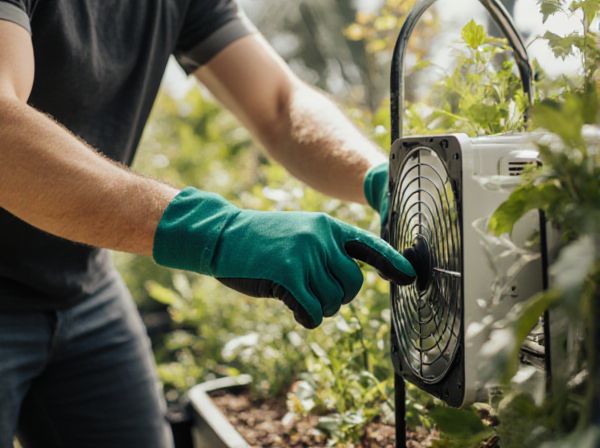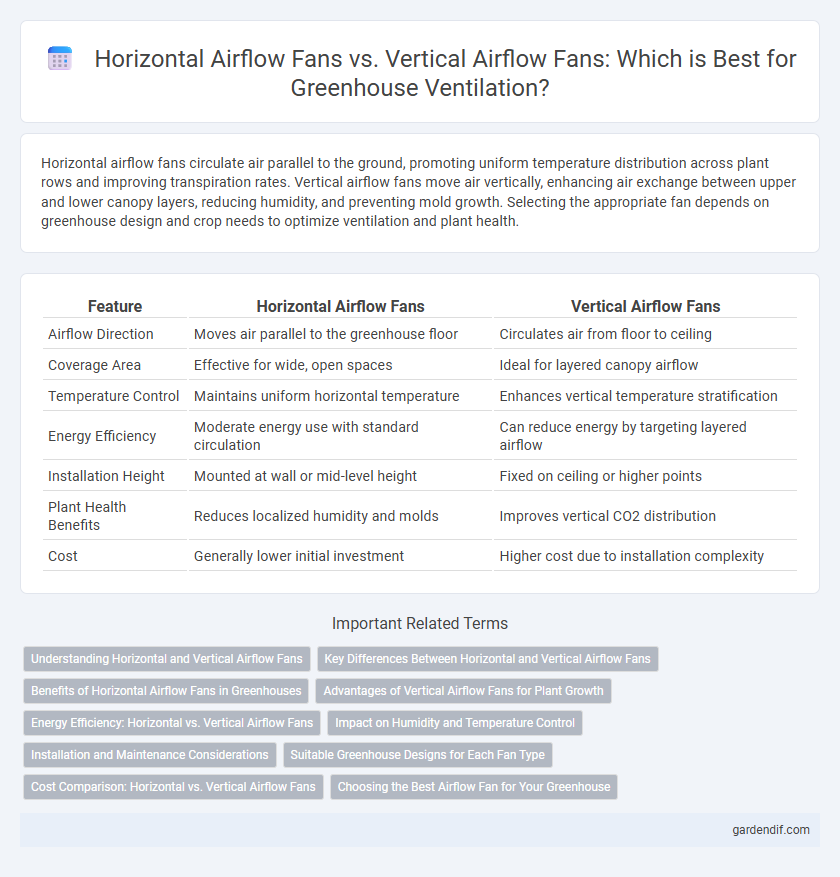
Horizontal airflow fans vs vertical airflow fans Illustration
Horizontal airflow fans circulate air parallel to the ground, promoting uniform temperature distribution across plant rows and improving transpiration rates. Vertical airflow fans move air vertically, enhancing air exchange between upper and lower canopy layers, reducing humidity, and preventing mold growth. Selecting the appropriate fan depends on greenhouse design and crop needs to optimize ventilation and plant health.
Table of Comparison
| Feature | Horizontal Airflow Fans | Vertical Airflow Fans |
|---|---|---|
| Airflow Direction | Moves air parallel to the greenhouse floor | Circulates air from floor to ceiling |
| Coverage Area | Effective for wide, open spaces | Ideal for layered canopy airflow |
| Temperature Control | Maintains uniform horizontal temperature | Enhances vertical temperature stratification |
| Energy Efficiency | Moderate energy use with standard circulation | Can reduce energy by targeting layered airflow |
| Installation Height | Mounted at wall or mid-level height | Fixed on ceiling or higher points |
| Plant Health Benefits | Reduces localized humidity and molds | Improves vertical CO2 distribution |
| Cost | Generally lower initial investment | Higher cost due to installation complexity |
Understanding Horizontal and Vertical Airflow Fans
Horizontal airflow fans in greenhouses distribute air parallel to the ground, promoting even temperature and humidity throughout crops, which is crucial for uniform plant growth. Vertical airflow fans push air up or down, enhancing ventilation by removing hot air from the canopy or bringing cooler air from below, essential for controlling microclimates in tall or multi-tiered crops. Choosing between horizontal and vertical airflow fans depends on greenhouse structure, crop type, and airflow efficiency needed to optimize photosynthesis and disease prevention.
Key Differences Between Horizontal and Vertical Airflow Fans
Horizontal airflow fans primarily move air parallel to the ground, promoting more uniform temperature distribution across greenhouse benches and plant canopies. Vertical airflow fans circulate air vertically, enhancing ventilation by moving hot air upward and cooler air downward, which helps in controlling humidity and preventing hotspots. Key differences include airflow direction, impact on microclimate control, and suitability for specific greenhouse layouts and plant types.
Benefits of Horizontal Airflow Fans in Greenhouses
Horizontal airflow fans enhance air circulation by evenly distributing temperature and humidity across greenhouse crops, reducing hotspots and improving plant growth consistency. These fans optimize energy efficiency through uniform airflow patterns, lowering heating and cooling costs while promoting healthier plants. Horizontal airflow fans also minimize disease occurrence by reducing stagnant air zones, crucial for maintaining optimal greenhouse microclimates.
Advantages of Vertical Airflow Fans for Plant Growth
Vertical airflow fans promote uniform air distribution by pushing air downwards, enhancing temperature regulation and reducing humidity pockets in greenhouses. This consistent airflow improves photosynthesis efficiency and minimizes fungal diseases, creating an optimal environment for plant growth. Their design also facilitates better CO2 circulation, which supports healthier and faster crop development.
Energy Efficiency: Horizontal vs. Vertical Airflow Fans
Horizontal airflow fans typically offer higher energy efficiency in greenhouses by providing broader air distribution with minimal power consumption, reducing the need for multiple units. Vertical airflow fans, while effective for targeted ventilation, often require greater energy input to achieve uniform air circulation throughout the canopy. Selecting horizontal airflow fans can lead to significant energy savings and improved climate control in greenhouse environments.
Impact on Humidity and Temperature Control
Horizontal airflow fans promote consistent air circulation across the greenhouse floor, enhancing uniform temperature distribution and reducing localized humidity pockets, which helps prevent fungal growth. Vertical airflow fans drive air vertically, facilitating stratified temperature layers and effectively removing moist air near plant canopies, thus improving humidity control in taller greenhouses. Selecting between horizontal and vertical airflow fans significantly influences microclimate stability, impacting plant health and growth efficiency.
Installation and Maintenance Considerations
Horizontal airflow fans offer simpler installation due to their straightforward mounting on greenhouse sidewalls, requiring minimal structural modifications and allowing easy access for routine maintenance. Vertical airflow fans, often installed in roof or ceiling spaces, demand more complex structural support and professional installation, which can increase initial setup time and costs. Maintenance for horizontal fans is generally more accessible, while vertical fans may require specialized equipment for cleaning and servicing, impacting long-term upkeep efficiency.
Suitable Greenhouse Designs for Each Fan Type
Horizontal airflow fans are ideal for long, narrow greenhouse designs where air needs to be circulated evenly along the length of the structure, promoting uniform temperature and humidity levels. Vertical airflow fans work best in taller greenhouse designs with higher ceilings, enabling efficient vertical air movement to prevent heat stratification and enhance air exchange at multiple canopy layers. Selecting the appropriate fan type depends on the greenhouse dimensions and crop requirements to optimize microclimate control and plant growth.
Cost Comparison: Horizontal vs. Vertical Airflow Fans
Horizontal airflow fans generally cost less upfront due to simpler design and manufacturing processes compared to vertical airflow fans, which often incorporate advanced features for enhanced air distribution. Operating expenses can also vary, with horizontal fans typically consuming less energy in smaller greenhouses, while vertical airflow fans may provide more efficient circulation in larger or multi-level structures, potentially lowering long-term energy costs. Maintenance costs tend to be lower for horizontal fans given their easy accessibility and fewer mechanical components.
Choosing the Best Airflow Fan for Your Greenhouse
Horizontal airflow fans promote uniform air distribution by pushing air laterally across plant canopies, reducing hotspots and enhancing transpiration rates essential for plant health. Vertical airflow fans move air up and down, aiding in temperature stratification control and preventing heat buildup near the greenhouse roof, which is critical for maintaining optimal growing conditions. Selecting the best fan depends on greenhouse structure, crop type, and climate control needs to maximize ventilation efficiency and plant growth.
Horizontal airflow fans vs vertical airflow fans Infographic

 gardendif.com
gardendif.com